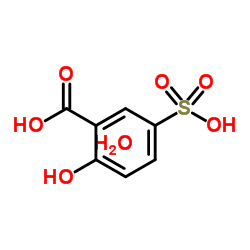2-Hydroxy-5-sulfobenzoic acid dihydrate

2-Hydroxy-5-sulfobenzoic acid dihydrate structure
|
Common Name | 2-Hydroxy-5-sulfobenzoic acid dihydrate | ||
|---|---|---|---|---|
| CAS Number | 5965-83-3 | Molecular Weight | 254.214 | |
| Density | 0,8 g/cm3 | Boiling Point | 705.7ºC at 760 mmHg | |
| Molecular Formula | C7H10O8S | Melting Point | 105-110 °C(lit.) | |
| MSDS | Chinese USA | Flash Point | 150°C | |
| Symbol |

GHS07 |
Signal Word | Warning | |
|
Brief reports: Lysosomal cross-correction by hematopoietic stem cell-derived macrophages via tunneling nanotubes.
Stem Cells 33(1) , 301-9, (2014) Despite controversies on the potential of hematopoietic stem cells (HSCs) to promote tissue repair, we previously showed that HSC transplantation could correct cystinosis, a multisystemic lysosomal storage disease, caused by a defective lysosomal membrane cys... |
|
|
Self-immolative polycations as gene delivery vectors and prodrugs targeting polyamine metabolism in cancer.
Mol. Pharm. 12(2) , 332-41, (2015) Polycations are explored as carriers to deliver therapeutic nucleic acids. Polycations are conventionally pharmacological inert with the sole function of delivering therapeutic cargo. This study reports synthesis of a self-immolative polycation (DSS-BEN) base... |
|
|
In vitro evaluation of inorganic mercury and methylmercury effects on the intestinal epithelium permeability.
Food Chem. Toxicol. 74 , 349-59, (2015) The mercurial forms [inorganic divalent mercury, Hg(II) and methylmercury, CH3Hg] produce neurological and immune effects as well as hematological and renal alterations. The main route of exposure is through the diet. Consequently, the gastrointestinal mucosa... |
|
|
Rapid determination of PEGylated liposomal doxorubicin and its major metabolite in human plasma by ultraviolet-visible high-performance liquid chromatography.
J. Chromatogr. B. Analyt. Technol. Biomed. Life Sci. 779(2) , 259-69, (2002) A high-performance liquid chromatographic method was developed for the quantification of doxorubicin derived from PEGylated liposomal doxorubicin (Doxil) and its major metabolite in human plasma. This method utilizes Triton X-100 to disperse the liposome, fol... |
|
|
Identification of protonation state by XPS, solid-state NMR, and DFT: characterization of the nature of a new theophylline complex by experimental and computational methods.
J. Phys. Chem. B 114(44) , 13961-9, (2010) Recent studies suggested that X-ray photoelectron spectroscopy (XPS) sensitively determines the protonation state of nitrogen functional groups in the solid state, providing a means for distinguishing between co-crystals and salts of organic compounds. Here w... |
|
|
Spray reagent for the detection of amino acids on thin layer chromatography plates.
Amino Acids 4 , 193, (1993) A spray reagent for easy identification of amino acids on thin-layer chromatography plates has been introduced. The reagent is capable of developing various distinguishable colours with many of them. A probable mechanism for such colour formation has also bee... |
|
|
Charge transport and optical and magnetic properties of polyaniline synthesized with use of organic acids.
Phys. Rev. B. Condens. Matter Mater. Phys. 47 , 13189, (1993)
|
|
|
Hydrogen bonding in proton-transfer compounds of 5-sulfosalicylic acid with ortho-substituted monocyclic heteroaromatic Lewis bases. Smith G, et al.
J. Chem. Crystallogr. 36(12) , 841-49, (2006)
|
|
|
Poly [[tris (di-2-pyridylamine) tris (μ-5-sulfonatosalicylato) tricopper (II)] trihydrate]. Fan SR and Zhu LG.
Acta Crystallogr. Sect. E Struct. Rep. Online 61(1) , m174-m176, (2004)
|